| 1 |
 |
Page 1
“...Published by the Chefoo Schools Association
The Chefoo Magazine
2009
PASSING THE BATON
FEA TUR ED IN THIS ISSUE
Past CSA Presidents 7
Recent Movies of China: Up the Yangtze, & The Children of Huang Shi 14
Escape from the Japanese, by Faith (Rowe) Cook; illustrations by Clarence Frencham 16
Philanthropy in China, by Blake Bromley 21
Essential Services: Canada's role with the Chinese Labour Corp, WWI, by Judy Lam Maxwell 26
Our Honorary Executive 36
The Salvation Army Band at Weihsien, by Peter Bazire 40
Photo Galleries 32-34
Full Table of Contents 3
Marjorie Keeble replaces James H. Taylor III As President of our Association.
It was with sadness that we learned that
Dr. James Hudson Taylor III passed away on March 20 of this year in Hong Kong, after a gallant struggle with cancer. Dr. Taylor was the great grandson of the founder of the China Inland Mission, and had served as the President of the Chefoo Schools Association since 1995. He formally resigned his position as President in February...”
|
|
| 2 |
 |
Page 2
“...The Chefoo Magazine 2009
Page 2
EDITOR’S NOTEBOOK
to the secowd cAtArAct surgery — wo more eye drops, wor weArlwg aw eye grArd At wight.
My yorwger brother, Mew, Also hAd CAtArAct srrgery, eArller lw 2002, Awd he
l toofe. his Advice. The polwt Is to mAlve It rwwecessAry to weAr glAsses, most of the terne— owe eye Allows owe to reAd, the other to see the girls; oops, I meAw dlstAwces. AmAzlwgly, for the most pArt the brAlw grlclvly Adjusts, Awd a persow doesw't wotlce thAt owe eye Is AlwAys ort of focrs. Bott slwce Abort 25jo of the poprlAtlow cAwwot mAlve this Adjrstmewt, I spewtpArt of 2002 experlmewtlwg with cowtAct lewses, Awd cAme throrgh with flylwg colors.
Although my eye-sight Is wow VAstly Improved, It still Is wot as good as 20/20 vlslow. There Is spAce from Abort two feet AWAy to Arorwd five feet thAt welther eye Is lw shArp focrs, so I hAVe prrchAsed two pAlr of reAdlwg glAsses, owe to weAr Iw my strdy where I rse my comprter, Awd the other rpstAlrs where I reAd the wewspAper...”
|
|
| 3 |
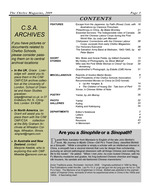 |
Page 3
“...Maxwell Chefusians’ Connections with the Chinese Labour 28
Corps, excerpts from early Chefoo Magazines Our Honorary Executive 36
The Salvation Army Band at Weihsien, 1943-1945, by 40
SHORT Peter Bazire Mrs. Binks and Grade Fields, by Gilbert Dunachie 13
STORIES My Hobby of Photography, by Steve Metcalf 24
Who was the First White Woman in China? by Oscar 30
Armstrong Grandmother’s Photograph, by Estelle (Cliff) Horne 31
MISCELLANEOUS Reprints of Gordon Martin Books 6
Past Presidents of the Chefoo Schools Association. 7
Recommended Movies on China (in DVD format): • Up the Yangtze, & 14
• The Children of Huang Shi: Tale born of Peril 15
Xinran, A Chinese Writer of Note 25
POETRY Yantai, by Jim Murray 35
PHOTO Yantai 32
GALLERIES Kuling 33
Kiating and Kalimpong 34
DEPARTMENTS Editor’s Notebook 2
Letters 4
News 8
Reunions 43
In Memoriam 47
Are you a Sinophile or a Sinopattfi
Daniel Reid, translator from Mandarin to English of the late John Blofeld’s book, My Journey in Mystic China—Old...”
|
|
| 4 |
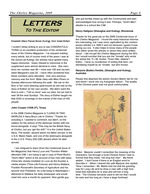 |
Page 4
“...John Cooper (1936-37), Texas
In the 2006 Chefoo Magazine is "LIVING IN TWO WORLDS A Navy Boy's Life in Chefoo." Thanks for including it. I wanted to comment, but didn't, on the caption for the picture of the destroyer tender with her brood alongside. It says "This may be the British Navy at Chefoo, but you 'get the drift.'" It is the United States Navy. The tender, aboard which my father served, is the U.S.S. Black Hawk, and one of the destroyers alongside is the U.S.S. Peary (DD-226) aboard which he later served.
I am intrigued to learn (from the Centennial issue of the Magazine) that Henry Luce and Thornton Wilder attended CIM. I am trying to get a copy of Pearl Buck's "God’s Men" which is the account of two men with deep China ties closely modeled on Luce as the founder a media empire (Time-Life-Fortune) and Henry Wallace, Franklin Roosevelt's Secretary of Agriculture and his second Vice President. As a kid living in Washington I delivered to Wallace his daily newspaper and would meet...”
|
|
| 5 |
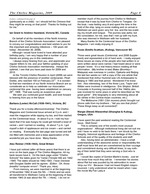 |
Page 5
“...The Chefoo Magazine, 2009
Page 5
(Letters, continued from page 4)
(particularly as a child) - so I should tell the Chinese that they might be wrong on that point! Thanks for finding out for me.”
Ian Grant to Andrew Hazeland, Victoria BC, Canada
On behalf of all the members of the North America Branch of the Chefoo Schools Association I am pleased to convey our congratulations and best wishes to you for this important and amazing milestone - 100 years old today! (November 30, 2008).
Although I would have loved to have attended your birthday party, I am very happy that a number of your friends are joining you in this celebration.
I always enjoy hearing from you, and appreciate your regular letters to me, and your faithful updating of your Chefoo Schools Association membership. Always the optimist, I see that you have paid dues for 2009 and 2010.
At the Toronto Chefoo Reunion in April (2008) we were blessed with the presence of another centenarian, Pearl Dobbs, who reached 100 on February...”
|
|
| 6 |
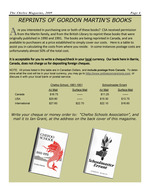 |
Page 6
“...Schoolmaster Errant
Air Mail Surface Mail Air Mail Surface Mail
Canada $16.75 $11.25
USA $20.80 $15.30 $13.75
International $27.60 $22.70 $22.10 $16.60
Write your cheque or money order to: "Chefoo Schools Association", and mail it to Ian Grant, at the address on the back cover of this magazine....”
|
|
| 7 |
 |
Page 7
“...The Chefoo Magazine, 2009
Page 7
Past Presidents of the Chefoo Schools Association
as gleaned from the Chefoo Magazine
NAME YEARS COMMENTS
Harold Judd 1912-1922 • 1912 issue first to show the officers. It showed Judd as President, but Editor’s Notes stated that he agreed to continue as President. Not sure when first appointed • Sept. 1922 still showed Judd as President • April 1923 issue left position of President vacant.
F. McCarthy, (& Mrs. McCarthy) 1925-1945 • The June 1925 issue showed McCarthy as President • December 1929 showed Mr. & Mrs. McCarthy as Presidents • December 1945 showed only Mr. McCarthy as President
Mr. McCarthy & P.A. Bruce 1947-1954 • December 1947 first to show McCarthy & Bruce as Presidents
P.A. Bruce 1954-1972 • July 1954 issue showed just Bruce as President • December 1972 last issue to show Bruce as President • Next two issues showed position vacant
H.F. Joyce 1974-1994 • July 1974 issue first to show him President • Summer 1994 last issue to show him as President...”
|
|
| 8 |
 |
Page 8
“...The Chefoo Magazine, 2009
Page 8
NEWS
Norman Austin (Kiating, Kalimpong, Shanghai & Kuling), writing from his home in Florida
David Eaton, who was in the Form below me at Kuling, and his wife Ann and I were able to meet in Orlando in April (2009). David and I were friends in Kuling but we had not seen each other since we left Kuling in 1951. David returned with his parents to the US and the Austins took up residence in Toronto. Several years ago Dave and I connected with each other via the internet and have stayed in touch ever since with e-mail
messages back and forth. Finally, we were able to work things out so that we could spend some time together (it was Maundy Thursday). We had a great time together, enjoying shared memories but also stories of our lives and careers since Kuling. It was a pleasure for me to meet Dave's wife Ann, and she was very patient as Dave and I told our China stories. It was a beautiful meeting, finding that though we had last seen each other when we were teenagers...”
|
|
| 9 |
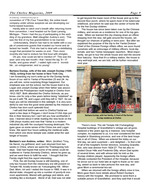 |
Page 9
“...am forwarding my son's write-up for the Dunlap family forum of our visit to Yantai of November 23 and 24. As you will see, some surprising things happened. Our emphasis was not the school, but the house lived in by Logan and Joseph Dunlap when their father was associated with the Presbyterian--built hospital in Chefoo from 1912-1927. Both attended the Chefoo Schools, as you know--Joe for only a few years before being "sidelined" as he put it with TB, and Logan until they left in 1927. So we hope you will be interested in this sidelight. It is very wonderful to see how the good seed planted by the mission in Chefoo has born such splendid food.
I will add that before we went to Chefoo/Yantai we spent a few days in Pingyao--I don't know if CSA trips put this in their itinerary but I can't tell you how worthwhile it was. I learned about it while reading the new book on the CIM (Alvyn Austin) and now that Yantai is a modern industrial city with the courtyard housing destroyed, Pin-gyao gave us...”
|
|
| 10 |
 |
Page 10
“...especially of the two we lost this year, Logan and Frankie. In a poem he wrote about his childhood in Chefoo, Dad described it as "the world that dieth with us," and that's generally true. But between the house and the Hospital, there is a part of that world that is still living, that still remembers the Dunlap family and its contributions to the city, that honors those contributions, and that Robert W. Dunlap's descendants can point to with pride.
Jack Fitzwilliam (1935-1945), Indiana USA
I, along with my wife Alice and son Steve went on a fantastic trip to southeast Asia this Spring. The reason for the trip was an invitation to go to Rangoon, Burma to be at the dedication celebration for the completion of the Zaiwa translation of the New Testament. In 1935, at the start of their second term with the CIM, my parents first went to Chefoo so that I would start my years at Chefoo Schools. They then traveled back to southwest China, to the far western section of Yunnan province in the mountains...”
|
|
| 11 |
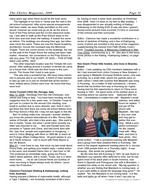 |
Page 11
“...The Chefoo Magazine, 2009
Page 11
many years ago when there would be the boat races.
The highlight of our time in Yantai was the visit to the old school compound. After some special arrangements had been made, we were finally permitted on the compound, however we could only go as far as the area in front of the Prep School and the Co-Ed classroom building. I was able to walk up the Prep School steps to the front door and look down the hallway. It looked the same as before. The buildings are showing their age, but otherwise much the same. These are now the Naval Academy dormitories. Across the courtyard was the Memorial Chapel. There are corner stones on the buildings, the one on the wall of the Prayer Room the writing has been obliterated. However, the cornerstone on the Prep School is still very clear-"TO THE GLORY OF GOD - THIS STONE WAS LAID APRIL 1933".
The other important location was the Temple Hill compound. After walking around a number of streets we came on a house that I think...”
|
|
| 12 |
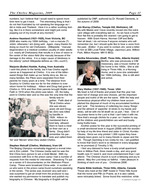 |
Page 12
“...happened at Chefoo. It is one of the bittersweet things that make up our family story as, like so many families, the Pikes were separated from their parents for many years at a time. The distance from Guizhou to Chefoo was too far for the children to ever return home for holidays. Allison and Doug had gone to Chefoo in 1914 and then their parents brought Walter and Faith in 1919 when this photo was taken. Alf, the baby, went to Chefoo later and so this was the only time that the family was together. Faith died of TB at Chefoo when she was eleven years old and Douglas (Snr) was killed by bandits in 1929. Allison remembered that a kind lady allowed them to have a meal on their own as a famly. Doug didn't remember his parents and called them
'Sir' and 'Ma'am' when they visited Chefoo.
Stephen Metcalf (Chefoo, Weihsien), from UK
The Beijing Olympics remarkably triggered a revival interest in Eric Liddell. The Chinese media said he was the first China born person to win a Gold Medal. With my connection...”
|
|
| 13 |
 |
Page 13
“...The Chefoo Magazine, 2009
Page 13
(News, continued from page 12)
others appreciated what Prairie had to offer us. However, in the late 1960s OMF decided to move the home to Newmarket, Ontario. It closed permanently a few years later.
Prairie Bible Institute, with OMF Hostel in white box in foreground, c. 1958
Word now is that PBI, like quite a number of other Bible schools in North America, is in financial difficulties, and may move to the nearby City of Drumheller, famous for its dinosaur graveyard and museum, where they have been offered an abandoned hospital. Apparently it is exploring the feasibility of joining with one or two other Alberta institutions that are also suffering financial woes. The Three Hills campus is large and many of its buildings are old and expensive to maintain. In recent years PBI has torn some buildings down and sold the property. But it still suffers from a fairly expensive infrastructure. Apparently some time ago the institute ignored pleas that they move to...”
|
|
| 14 |
 |
Page 14
“...The Chefoo Magazine, 2009 Page 14
Two Recommended Movies of China
Available on DUD
UP THE YANGTZE
A documentary on social and environmental change on China's Yangtze River. Written and directed by Yung Chang. 93 minutes. Reviewed by movie critic Peter Howell, October 7, 2008, reprinted here with permission of the Toronto Star newspaper
T Tp the Yangtze tells one huge story, the impending drowning of hundreds of square kilometers of homes, farmland and archaeological sites along China’s fabled waterway by the Three Gorges Dam hydro project.
The film also tells several smaller tales, and therein lies the more significant achievement by Montreal filmmaker Yung Chang, who follows an acclaimed National Film Board short (Earth to Mouth) with this ambitious first feature.
In documenting the potential ecological disaster Three Gorges represents, Chang wisely eschews stridency and statistics to make his point. Instead he and lenser Wang Shi Qing use powerful images, subtlety and a little humour...”
|
|
| 15 |
 |
Page 15
“...The Chefoo Magazine, 2009
Page 15
Yu Shui, Chen Bo Yu and their co-workers are all told how to get along with tourists: “Don’t call anybody old, pale or fat.”
They’re also encouraged not to talk about politics, especially those to do with the Three Gorges Dam. But Chang’s camera ferrets out numerous telling details: a businessman along the river first speaks proudly of how sacrifices must be made for the common good, then he dissolves into tears: “China is too hard for common people,” he cries.
The camera speaks eloquently and urgently: it gazes upon ancient temples that will soon be submerged and
ugly concrete and steel structures that now dominate the Yangtze. This subtle approach fails only in providing needed identification. The film’s overall impact, however, is immense and unforgettable. We are paying witness to an historic event that will have world-wide ecological and cultural ramifications, something the pampered Yangtze tourists may not realize.
“Most of the tourists are here...”
|
|
| 16 |
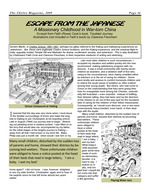 |
Page 16
“...The Chefoo Magazine, 2009
Page 16
ESCAPE FROM THE JAPANESE
A Missionary Childhood in War-torn China
Excerpt from Faith (Rowe) Cook’s book, Troubled Journey;
Illustrations (not included in Faith’s book) by Clarence French am
Gordon Martin, in Chefoo School, 1881-1951, perhaps too glibly referred to the Kiating and Kalimpong experiences as ‘sideshows’. But these were legitimate Chefoo School locations, and the Kiating experience, and the eventual flight to India, arguably rivaled Temple Hill and Weihsien for drama, excitement, anxiety, and adventure. This is ably illustrated by Chefusians Faith Cook and Clarence Frencham, in their respective mediums of writing and sketching.
I learned that the day was very close when I must leave the familiar surroundings of home and make the long trek to Kiating to join Christopher at his boarding school. Late in August (1944) our journey was to begin. Stretching out pleading arms in useless protest, I was lifted on to the lorry that would take me, accompanied...”
|
|
| 17 |
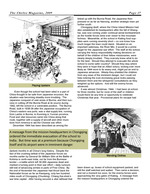 |
Page 17
“...The Chefoo Magazine, 2009
Even though the school had been sited in a part of China thought to be safe from Japanese incursion, the situation was becoming steadily more troubling. The Japanese conquest of vast areas of Burma, and their success in cutting off the Burma Road at its source during 1942, left the school in a vulnerable position. The Burma Road, built in 1938-39 after the Japanese occupation of China’s eastern sea ports, was a vital supply line, running from Lashio in Burma, to Kunming in Yunnan province. Food and vital resources came into China along that route, together with a supply of aircraft and other munitions from America to aid the Chinese war effort.
December 1944 has been described as among the
A message from the mission headquarters in Chongqing ordered the immediate evacuation of the school to India. But time was at a premium because Chongqing itself and its airport were in imminent danger.
darkest months in all China’s long history. Despite the fact of the crushing...”
|
|
| 18 |
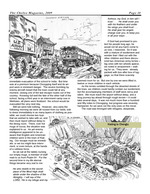 |
Page 18
“...The Chefoo Magazine, 2009
Page 18
immediate evacuation of the school to India. But time was at a premium because Chongqing itself and its airport were in imminent danger. The severe bombing by enemy aircraft meant that the town could fall at any moment, closing one of the last escape routes out of the country. Knowing full well the fate of the other half of the school, facing a third year in an internment camp now in Weihsien, all plans were finalized: the school would be evacuated the very next day.
Still we were told nothing. However, very early the following morning we were all roused from our beds, told to dress immediately in as many layers of clothing as possible; we could choose two toys that we wished to take with us, and then must report without delay to the dining room. There, over hot mugs of cocoa, the situation was explained to us. As yet enemy intelligence appeared to be unaware that English and American children were in the town of Kiat-ing. Our escape must be immediate,...”
|
|
| 19 |
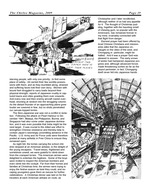 |
Page 19
“...The Chefoo Magazine, 2009
Page 19
Christopher and I later recollected, although neither of us had any appetite for it. The thought of Christmas pudding, together with the haunting smell of chewing gum, so popular with the Americans, has remained forever in my mind, invariably connected with that flight from danger.
Earnest prayer had been offered by local Chinese Christians and missionaries alike that the Japanese onslaught on the cities of the west, and Chongqing in particular, might be halted. And it was a prayer God was pleased to answer. The early snows of winter had hampered Japanese progress and, although advanced forces made threatening sorties as far as the airport perimeter, in fact, Chongqing itself never fell into Japanese hands.
starving people, with only one priority: to find some place of safety. All carried their few worldly possessions with them, and as they stumbled along, strained and suffering faces told their own story. Women with bound feet struggled to carry loads...”
|
|
| 20 |
 |
Page 20
“...Page 20
The Chefoo Magazine, 2009
Called the ‘Mountain City’, old Chongqing was built on the steep surrounding mountains, at the meeting point of two great waterways: China’s longest river, the Yangtze, and the Jialing River. These geographical features had proved of vital importance in the defense of the city.
With the closure of the vital supply routes along the Burma Road and any way of exit from the country by means of the eastern sea ports, the American Air Force had pioneered a new air route from China into India flying across ‘the Hump’, as the eastern end of the Himalayan range was dubbed. With aircraft of that time unable to gain the flying altitudes commonplace today, the attempt to clear mountains that reached a phenomenal 20,000 feet was exceptionally hazardous. The extreme air turbulence at such altitudes had resulted in many aircraft being lost as they attempted to cross the Hump. But there was no alternative. In addition, the oxygen supply at those heights was so thin that...”
|
|